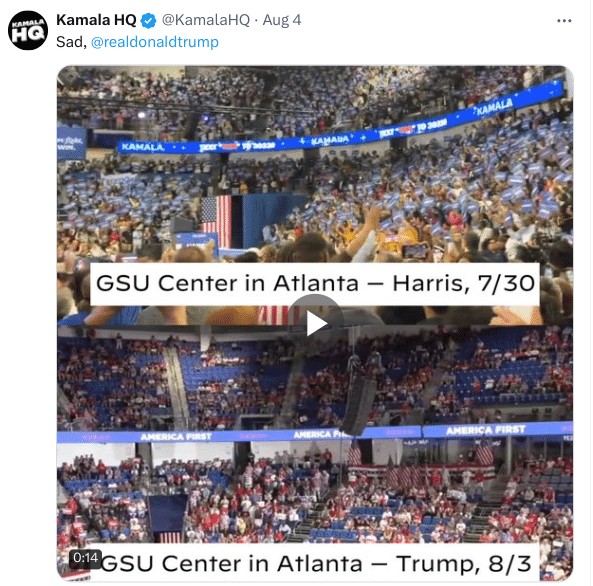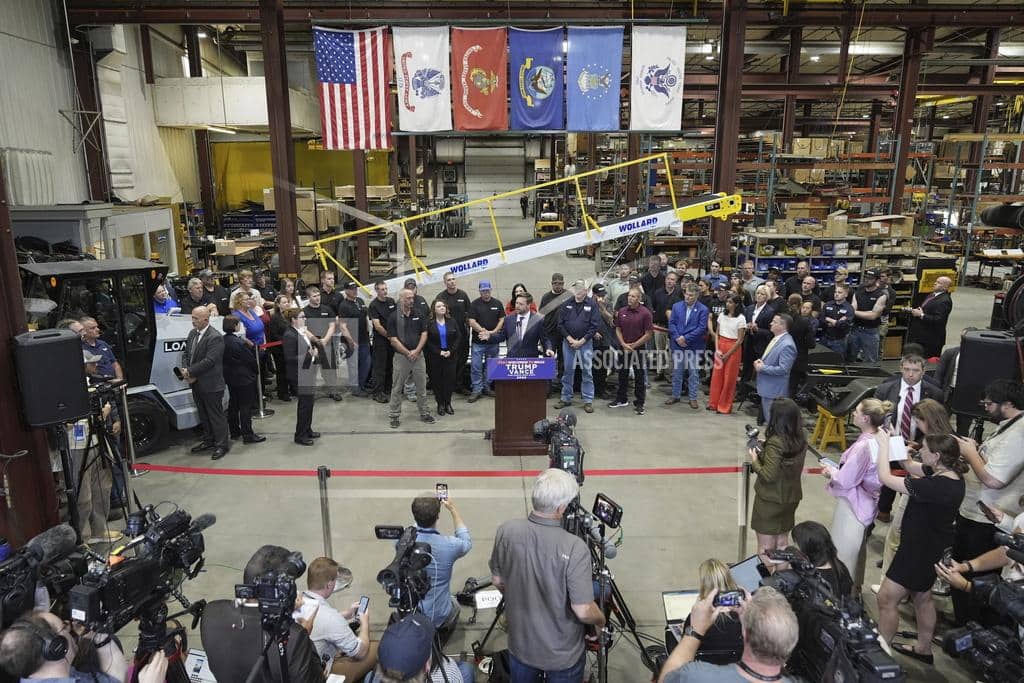The second I saw video of Vice President Harris rolling up to a hangar at Detroit’s airport on Air Force Two, then alighting with Tim Walz in front of cheering crowds, I knew it would break Donald Trump’s brain.

This is the kind of spectacle Donald Trump excels at creating.
This is the kind of spectacle on which Trump has built slavering loyalty from millions of MAGAts who see power in such spectacle.
And a Black woman created it.
Or rather, a Black woman and her campaign team, a campaign team which has already demonstrated they know exactly how to trigger Donald Trump, created it.
And sure enough, it did melt his brain.
Yesterday, he adopted the hysterical claims of some of his followers, posting that Vice President Harris was cheating because (he falsely claimed) she had used AI to sub in a crowd of people who weren’t there.

In fact, some of Trump’s followers were the ones who had used AI, sometimes marked as fake, sometimes not. to give the appearance this crowd didn’t exist.

Trump’s claims are so obviously false that even right wing trolls like Ian Miles Cheong are criticizing him for it.

And Cheong is not the only right wing troll complaining that Trump is hurting the movement, their movement, with his unhinged response to Vice President Harris’ rally. At a time when some prominent right wing trolls are showing RFK-curiosity, they’re also questioning the campaign, in significant part because of Trump’s public meltdown over this arrival.
And that’s where things start to get weird.
Both WaPo and NYT reported overnight on Trump’s unhinged claim.
But they’re both missing a bit of what’s going on, and they’re missing it, in my opinion, because they’re still seeing this race from Trump’s perspective.
In a piece on Saturday, WaPo claimed that Democrats were obsessing over crowd size in their own right, citing Tim Walz’ boast about crowd size in a Friday rally in Phoenix, even while (in the penultimate paragraph) quoting a Harris spox mocking Trump for the meltdowns he has in response.
Then the vice-presidential pick beamed out at the audience in suburban Phoenix — more than 15,000 people, Democrats said — and delivered the punchline with a big grin.
“It’s not as if anybody cares about crowd sizes or anything,” Walz said.
For years Trump, the GOP nominee for president, has been the one boasting about how many people he could pack into a venue. Now Democrats are eager to play the crowd game, too. With enthusiasm surging for their new presidential ticket, they have spent the week needling Trump on a topic he famously obsesses over.
[snip]
Harris campaign spokesperson Sarafina Chitika said Trump has been “rage-Truthing about our grassroots enthusiasm and melting down publicly, both online and in front of cameras” while Harris and Walz hit battleground states.
After Trump’s unhinged post yesterday, WaPo and NYT observed that Harris’ campaign has begun to mock Trump for complaining about coverage of her crowds. WaPo’s version links back to the earlier piece treating this primarily as mere boasting.
Trump’s focus on crowd size also has become something that the Harris campaign has used to poke fun at Trump about — while at the same time bragging about their own crowds.
But they’re suggesting it only started in Phoenix on Friday, after the Trump presser.
That is, they’re misunderstanding the timeline, and therefore the full effect of it.
Both cite Trump’s conflated boast, given in his unhinged presser on Thursday, that his January 6 crowds were bigger than Martin Luther King Jr’s (this is the NYT; note, logically Trump must also be conflating January 6 and his inauguration, which is the only event where he occupied the same real estate MLK did).
Mr. Trump did not hold any events in a swing state last week. Instead, he held a rally in Montana, where there is a crucial Senate race, and a news conference at his Mar-a-Lago property in Florida.
Mr. Trump showed frustration with Ms. Harris’s crowds at that event, too, and even boasted about the crowd at his rally in Washington D.C., on Jan. 6, 2021, that preceded the riot at the Capitol, saying it was larger than the one drawn by Martin Luther King Jr. for his famous “I Have a Dream” speech.
“Nobody’s spoken to crowds bigger than me,” Mr. Trump claimed.
But they’re missing that the presser and the wildly inflated claims about crowd size took place the day after Kamala’s iconic arrival in Detroit. They’re missing that Trump’s first attempt to dismiss the Vice President’s crowd size came in that presser.
Trump announced the presser first thing in the morning on Thursday, to take place in conjunction with a briefing, purporting to inform reporters about the state of Trump’s campaign, already scheduled that day. So the presser would have come together in the period when Trump was seeing — and responding to — that imagery.
Trump called the presser when his brain was breaking after seeing this image.
And many people, including NYT’s weird write-up of the presser as if it were sound campaign strategy, did not report that in addition to inflating his own crowd sizes, Trump was falsely claiming that Kamala’s crowds were an order of magnitude smaller than they were.
Former President Donald J. Trump tried on Thursday to shoehorn himself back into a national conversation that Vice President Kamala Harris has dominated for more than two weeks, holding an hourlong news conference in which he assailed Ms. Harris’s intelligence and taunted her for failing to field questions similarly from journalists.
Throughout the event, held in the main room at Mar-a-Lago, his private club and home in Palm Beach, Fla., Mr. Trump assailed the state of the U.S. economy, described the country as in mortal danger if he did not win the presidential election and falsely described his departure from the White House — which was preceded by his refusal to concede his election loss in November 2020 and the violent attack on the Capitol on Jan. 6, 2021, by a mob of his supporters — as a “peaceful” transfer of power.
Mr. Trump also flashed frustration when asked about the size of Ms. Harris’s crowds while boasting about the attendance at his own rally on Jan. 6, 2021, and insisted that the group of hundreds that stormed the Capitol was relatively small. But he fixated on the size of the crowd that he initially gathered on the national mall, making comparisons to — and declaring it was larger than — the one drawn by Martin Luther King Jr. for his famous “I Have a Dream” speech.
“Nobody’s spoken to crowds bigger than me,” Mr. Trump said. “If you look at Martin Luther King, when he did his speech, his great speech, and you look at ours — same real estate, same everything, same number of people, if not — we had more.”
The Trump team has been looking for ways to interrupt Ms. Harris’s momentum as she has quickly consolidated the Democratic Party behind her and risen in the polls. The goal of Mr. Trump’s news conference, which he announced on Thursday morning on his social media site, was to highlight that Ms. Harris has yet to hold a news conference of her own or to give an unscripted interview to the news media.
On top of describing many of Trump’s false claims — that Kamala is stupid, that the economy is in poor shape, that Kamala was border czar and has let other countries unload prisons into the US, that the legal system was unfair to him, that crime is up — without correcting them, NYT only mentioned Trump’s false comparisons of his own rallies (again, without correction), not his claim that Harris had been getting 1,500 rally-goers, as opposed to 15,000.
Oh give me a break.
Listen. I had 107,000 people in New Jersey. You didn’t report it.
I’m so glad you asked. What did she have yesterday? 2,000 people?
If I ever had 2,000 people you’d say my campaign is finished. It’s so dishonest, the press. And here’s a great example.
I had, in Michigan recently, 25,000 people, and 25,000 people we just couldn’t get them in. We had, in Harrisburg, 20, 25,000 people? And 20,000 people couldn’t get in. We had so many — nobody ever mentions that!
When she gets 1,500 people — and I saw it yesterday on ABC, which they said, “oh, the crowd was so big,” — I have 10 times, 20 times, 30 times the crowd size, and they never say the crowd was big.
That’s why I’m always saying, “turn around the cameras.”
I’m so glad you asked that.
I think it’s so terrible, when you say, “she has 1,500 people, 1,000 people,” and they talk about, “oh, the enthusiasm.” Let me tell you. We have the enthusiasm. The Republican Party — and me, as a candidate — but the Republican Party has the enthusiasm, because people want to see crime stopped, they want to see a country that’s respected.
Trump’s false claims about this Detroit rally started when the wound was still fresh. Trump’s false claims started last Thursday, but few mentioned them as false claims until he went wildly unhinged on his social media site.
And understand: Harris’ campaign is intentionally goading him, intentionally causing these psychic wounds, and they were even before the Detroit rally.
I have no reason to believe that Harris’ campaign had the event in the airport hangar to prepare that spectacle (I think they had to move there once they overfilled their first venue), but holy hell it was great advance work. That said, their rapid response has been deliberately needling the former President with crowd size comparisons, going back a week now, days before Walz was even selected.
After both Georgia,

And Philly,

Kamala HQ posted side-by-side comparisons and, in the latter case, posted it to Truth Social. And Trump invited these comparisons when he booked a rally in the same Georgia auditorium as Kamala chose to do her rally. Trump made excuses for his paltry turnout in real time.
Trump invited this comparison, then failed to match up.
And the Kamala HQ account’s first take on Trump’s unhinged presser captioned it, “A feeble Trump holds a press conference to lie and yell about his noticeably smaller rally crowd sizes.”

Harris’ own campaign is not the only outlet that understood what was going on. Rolling Stone focused on Trump’s obsession about Harris’ crowd size on August 8, not long after the presser, which the KamalaHQ account noted and @ed Trump on.
According to one Republican source who’s spoken to the former president in recent days, Trump is “unhappy with the narrative” forming that Vice President Kamala Harris has been attracting high, enthusiastic attendance at the 2024 rallies she’s held since President Joe Biden dropped out of the race.
In private, Trump has recently taken to griping about the media attention the Harris 2024 (now Harris-Walz 2024) rally sizes have been receiving, and at times insisting a number the Harris campaign has put out must be “fake,” the source and another person familiar with the matter say.
And NYT hasn’t been entirely missing this. On August 9, they updated a story posted on August 4 about Trump’s excuses for his thin Georgia turnout.
Still, Mr. Trump couldn’t help but focus on those who weren’t piling in. He claimed that Georgia State University officials in charge of the arena prevented him from letting in more people. “We have beautiful cameras set up for the overflow crowds,” he said. A massive screen flashed to a live video feed of his red-capped supporters milling around outside in the 90-degree heat.
In Mr. Trump’s telling, this wasn’t a safety protocol but a conspiracy to humiliate him, perpetrated by the university and other nefarious forces. It all connects, in his estimation, to the biggest numbers game he has ever lost. “If they’re going to stand in the way of admitting people to our rally, just imagine what they’re going to do on Election Day,” he said.
This goes to the core of Mr. Trump’s crowd-size fixation. He seems to believe that a full arena is a predictor of his ultimate victory — as if the voters in that arena were representative of the country at large.
[snip]
[A]n hour into his speech, the Atlanta crowd had emptied out more than usual.
This is a known trigger for Trump. It has been, going back to his own meager inauguration turnout. It has been racialized since that point too, Trump’s insecurities knowing that a Black president could be more popular than he was.
Further, brags about crowd size are a known building block of Trump’s own false claims about elections. In 2020, for example, he argued it was impossible that Biden beat him because he never left his basement. There are still millions of people who believe Trump’s 2020 Big Lie because they believe his claim that crowd size directly translates to votes.
This time around, Trump is giving pressers in the equivalent of his own basement, arguing that so many people voted for him in Alabama and South Carolina in 2020, he must have won Georgia, even while he inflates his own crowd sizes by an order of magnitude and deflates the Vice President’s by the same margin.
The stakes, for Trump, have to do with his Big Lie, his ability to sustain the belief of his mob that he really is that much more popular than his opponent. He can’t have them see that Kamala can do crowds better even than he can.
Beyond triggering Trump, beyond goading him into melting down in front of campaign journalists, that’s actually not how the Harris campaign views it (nor should it be, in a competent campaign): The WaPo’s description of Trump’s false claims describe Harris boasting of new volunteers being recruited.
And at a fundraising event in San Francisco on Sunday, Harris appeared to address Trump’s social media accusations indirectly.
The energy around the country is “undeniable,” Harris said, adding, “The press and our opponents like to focus on our crowd size, and yes the crowds are large.” But even better, she said, attendees are signing up for volunteer shifts by the thousands.
This is actually the purpose rallies are supposed to serve at this point of a campaign, even one launched a mere three weeks ago. These crowds are important not (just) because they lead Trump to melt down, but because they’re a necessary way to catch up on volunteer recruitment Biden hadn’t been doing. This is why Walz, especially, makes an ask at every one of these rallies. This is why Kamala always talks about the hard work ahead.
This is about recruiting bodies to do voter identification, persuasion, and ultimately GOTV. This is about basic campaign work.
Trump, meanwhile, has sent JD out to speak to empty parking lots.
Pro-Trump trolls like Cheong see this. But full time campaign journalists are slow to catch on. They’re slow to understand that Trump’s own insecurities can be — and were, deliberately — triggered, with predictable results.
Especially when someone can mobilize the kind of spectacle that Trump himself relies on.





















